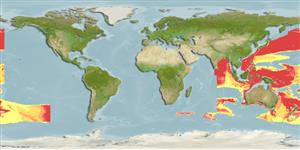>
Lophiiformes (Anglerfishes) >
Diceratiidae (Double anglers (Ref. 07463) or Doublespine Seadevils (Ref. 86949))
Etymology: Diceratias: Greek, di = two, double + Greek, keras or keratos = horn, horned (referring to the two conspicuous dorsal-fin spines in the larvae and young females) (Ref. 86949).
More on author: Günther.
Environment: milieu / climate zone / ระดับความลึก / distribution range
นิเวศวิทยา
เกี่ยวกับทะเล,น้ำเค็ม สัตว์ผิวน้ำในเขตน้ำลึก; ระดับความลึก 533 - 2306 m (Ref. 86949). Deep-water
Indo-Pacific: Bay of Bengal, Papua New Guinea and the Philippines.
ขนาด / น้ำหนัก / Age
วัยเจริญพันธุ์: Lm ? range ? - ? cm
Max length : 11.2 cm SL เพศผู้/กระเทย; (Ref. 39830)
Short description
เครื่องมือที่ใช้ในการแยกชนิดสัตว์,สิ่งมีชีวิตออกจากกัน | สัณฐานวิทยา | ความยาวต่างๆ
A species of Diceratias with esca having distinct anterior and posterior appendages.
Distinguishing characteristics of metamorphosed female: relatively small esca, width about equal to length; low rounded terminal escal papilla; well developed anterior and posterior escal appendages, usually bearing small secondary filaments; bulbous anterior escal appendage, sometimes branched; laterally compressed posterior escal appendage, row of small secondary filaments along outer margin, at most 5; posterobasal margin of terminal papilla with escal pore; lower jaw with 14-65 teeth, upper jaw with 18-99 teeth; vomerine teeth 4-9 (Ref. 86949).
Body shape (shape guide): short and / or deep.
Specimens captured in closing trawls or taken in open nets (Ref. 86949).
Life cycle and mating behavior
วัยเจริญพันธุ์ | การสืบพันธุ์ | การวางไข่ | เซลสืบพันธ์ของเพศเมีย(ไข่) | ความดกของไข่ | ตัวอ่อน
Kailola, P.J., 1987. The fishes of Papua New Guinea. A revised and annotated checklist. Vol. 1. Myxinidae to Synbranchidae. Research Bulletin No. 41. Department of Fisheries and Marine Resources, Port Moresby, Papua New Guinea. 194 p. (Ref. 6993)
IUCN Red List Status (Ref. 130435: Version 2024-2)
Threat to humans
Harmless
Human uses
เครื่องมือ
Special reports
Download XML
แหล่งที่มาจากอินเตอร์เน็ต
Estimates based on models
Preferred temperature (อ้างอิง
123201): 2.8 - 6.8, mean 4.5 °C (based on 969 cells).
Phylogenetic diversity index (อ้างอิง
82804): PD
50 = 0.6328 [Uniqueness, from 0.5 = low to 2.0 = high].
Bayesian length-weight: a=0.01995 (0.00906 - 0.04395), b=3.01 (2.83 - 3.19), in cm total length, based on all LWR estimates for this body shape (Ref.
93245).
ระดับชั้นอาหาร (อ้างอิง
69278): 4.2 ±0.73 se; based on food items.
Fishing Vulnerability (Ref.
59153): Low vulnerability (10 of 100).
🛈
